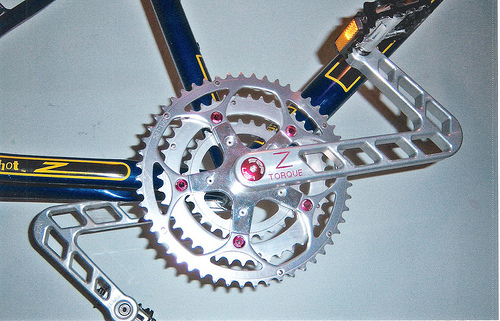TriByran wrote:
Dan,
Sorry if I have missed some important stuff in this thread, but your post has got me thinking Dan.
Sorry if I am about to butcher torque/force etc.
But in the instance of short cranks. I find the 155s I have feel like I have to generate too much force in too short a time for my long long legs (37inch inseam) to tolerate.
I find I have a limitation on rpm in aero position. Sat up Iâm fine. 100 on the turbo is no problem.
To counteract this, would a longer crank allow me to generate more torque to compensate for the lack of spin?
well, theoretically, you have this interplay: yes, you need to generate (a little bit) more torque with a shorter crank. and, not only is the lever (the crankarm) shorter, torque is force x that lever, and it's that x the cosine of the angle created between the diagonal perpendicular to the force and the line from the fulcrum of that angle (the BB) and the place on the pedal circle where you are at any moment - which is to say that there's only one perfect place on the pedal circle and you move away from that place incrementally more quickly on a smaller pedal cycle circumference, if time is the measure (just, i'm a little fuzzy on this part, i'd have to think this through a bit).
countering that is another mechanical element, which is your body. on the bicycle you have two machines at work, that interplay. your bicycle is a machine, with all its physical features. and your body is a machine, with its physical features. you have force applied at the end of a lever, right? but, what am i talking about? in the paragraph above it's the crank, and the BB is the fulcrum, and the crankarm is the lever. but i might also be talking about your hip as the fulcrum and the femur as the lever. this is where you gain back that mechanical disadvantage of the shorter crankarm. you begin to push down with a new mechanical advantage granted you by the shorter crank, assuming your retain your same aspect into the wind (identical armrest elevation drop from saddle to armrest pads).
here's something i'm pretty sure nobody offers you, but that i think might be fun. and i'm not offering it either, but bear with me. I have, what, 4 (i think) fit bikes in my studio: a GURU, an exit cycling, a purely custom, and another purely custom that just showed up and is still in the crate. they all have adjustable cranks. they all have smart resistance units. so i could put you on any one of these, in your position, and put you through a performance test, retaining your position exactly, just with different crankarm lengths. and you could see right there, in the course of, say, an hour, which crankarm is best for you.
Dan Empfield
aka Slowman




